History
& Location
Nestled on the banks of the
eternal Ganga, Kanpur stands as one of North India’s major industrial centres with
its own historical, religious and commercial importance.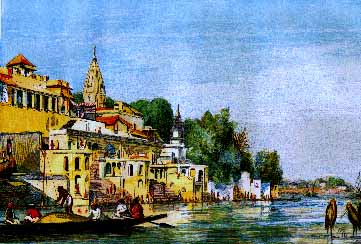 Believed to be founded by king Hindu Singh of the erstwhile state of Sachendi,
Kanpur was originally known as `Kanhpur’.
Historically, Jajmau on the eastern outskirts of present day Kanpur is
regarded as one of the most archaic tounships of Kanpur district.Upto the 1st
half of the 18th century Kanpur continued to survive as an insignificant village.
Its fate, however, took a new turn soon after. In May 1765,
Shuja-ud-daula, the Nawab Wazir of Awadh, was
defeated by the British near Jajmau. It was probably
at this time that strategic importance of
the site of Kanpur was realised by the British. European
businessmen had by this time gradually started
establishing themselves in Kanpur. In order to ensure protection to
their lives and property the `Awadh local forces’ were
shifted here in 1778. Kanpur passed into British hands under the treaty of
1801 with Nawab Saadat Ali Khan of Awadh. This forms a
turning point in the history of Kanpur. Soon Kanpur became one of the most
important military station of British India. It was declared a district on 24th March
1803.
Believed to be founded by king Hindu Singh of the erstwhile state of Sachendi,
Kanpur was originally known as `Kanhpur’.
Historically, Jajmau on the eastern outskirts of present day Kanpur is
regarded as one of the most archaic tounships of Kanpur district.Upto the 1st
half of the 18th century Kanpur continued to survive as an insignificant village.
Its fate, however, took a new turn soon after. In May 1765,
Shuja-ud-daula, the Nawab Wazir of Awadh, was
defeated by the British near Jajmau. It was probably
at this time that strategic importance of
the site of Kanpur was realised by the British. European
businessmen had by this time gradually started
establishing themselves in Kanpur. In order to ensure protection to
their lives and property the `Awadh local forces’ were
shifted here in 1778. Kanpur passed into British hands under the treaty of
1801 with Nawab Saadat Ali Khan of Awadh. This forms a
turning point in the history of Kanpur. Soon Kanpur became one of the most
important military station of British India. It was declared a district on 24th March
1803.
Kanpur in 1857
Kanpur was soon to become the
epicentre of the outbreak of 1857, as some of the leading luminaries of the War of
Independence hailed from her, namely – Nana Sahib, Tantiya Tope, Azimoolah Khan and
Brigadier Jwala Prasad. The three strategic events of the 1857 war at Kanpur were the
fight at `wheeler’s entrenchment’, the `massacre at Sati Chaura Ghat’ and
the `Bibighar massacre’. Nana Sahib had declared independence on th 7th of June 1857
at Kanpur. The British under Commander Hugh Wheeler retreated into a shallow earch
entrenchment in the cantonment area, later known in history as `wheeler’s
entrenchment’. The English garrison surrendered in the last week of June 1857 on
terms of safe passage to Allahabad. But when on the morning of 27th June, the soldiers
along with the women and children were about to embark into the boats at Sati Chaura Ghat,
fighting broke out and most of the men were killed. The survivors, women and children were
rescued who were imprisoned into the Savada Kothi and later shifted to Bibighar in the
`cantonment magistrates’ compound. But when it became clear the relieving forces
under General Havelock were nearing the city and defeat was inevitable, the captives-all
women and children, were massacred and their dismembered bodies buried in the well of the
compound on 15th July 1857. The Bibighar was dismantled by the British and reoccupation of
Kanpur and a `memorial railing and a cross’ raised at the site of the well. The well
is now bricked over. Only remains of a circular ridge survive, which can be still seen at
the Nana Rao Park. The Kanpur Memorial Church – `The all soul cathedral’ was
raised in honour of the fallen at the north-east corner of Wheeler’s entrenchment in
1862 by the British. The marble gothic screen with famous `mournful scarf’ was
transferred to the churchyard of All Souls after independence in 1947, and in its place a
bust of Tantiyu Tope installed as Nana Rao Park’.
After 1857, the development of Kanpur was even more phenomenal. Government Harnes and
Saddlery Factory was started for supplying leather material for army in 1860, followed by
Cooper Allen & Co. in 1880. The first cotton textile mill, the Elgin Mills were
started in 1862 and Muir Mills in 1882.
Old Picture Of
CAWNPORE Railway Station
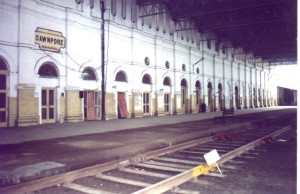
Courtesy : Om Chauhan, Times Of India
Today besides being the most industrialised region of the state, Kanpur is also an
important educational centre, with institutions like Harcourt Butler Technological
Institute, Agricultural College, Indian Institute of Technology, GSVM Medical College,
National Sugar Institute and Government Textile Institute being located here. Apart from
playing a stellar role in the development of the country as a whole, Kanpur has also been
instrumental in making an unforgettable contribution to the Indian freedam struggle. A
favourite centre of activities of stalwarts like Nanarao Peshwa, Tantiya Tope, Sardar
Bhagat Singh and Chander Shekhar Azar among others, Kanpur is also the birth place of
Shyamlal Gupta `Parshad’, composer of the famous patriotic ditty `Vijayee Vishwa
Tiranga Pyara’. The propagation and popularisation of Hindi also owes much to this
city, with great Hindu literatures like Acharya Mahavir Parasad Dwivedi, Ganesh Shanker
Vidyarthi, Pratap Narain Mishra, Acharya Gaya Prasad Shukla `Sanehi’ and Balkrishna
Sharma `Navin’ having hailed from here.
About the CITY
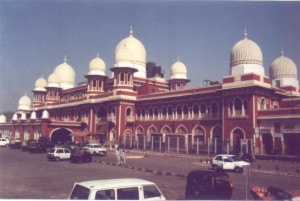
Kanpur Central Station
|
• Area |
1040 Sq. km. |
|
• Population |
2418447 (1991 census) |
|
• Altitude |
126 meters above sea level. |
|
• Season |
November-February |
|
• Clothing |
(Summer ): Cottons,
(Winter) : Woolen |
|
• Language |
Hindi & English |
|
• Local Transport |
Buses, Taxis, Tempos,
Auto-Rickshaws. |
|
• STD Code |
0512 |
Places of Interests
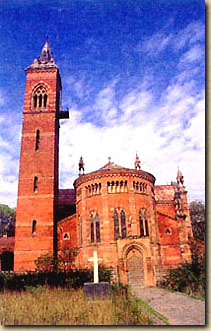 The Kanpur Memorial Church
The Kanpur Memorial Church
(All Soul’s Cathedral)
The Kanpur Memorial Church was built in 1875, in honour of the British who lost their
lives in the war of 1857. The Church was designed by Walter Granville, architect of the
east Bengal Railway. The complete Church in Lombardic gothic style is handsomely executed
in bright red brick, with polychrome dressings. The interior contains monuments to the
mutiny, including several memorial tablets.In the separate enclosure to the east of the
church is the Memorial Garden, approached through two gateways. Here the handsome carved
gothic screen, designed by Henry Yule, stands. Its centre is occupied by the beautiful
carved figure of an angle by Baron Carlo Marochetti, with crossed arms, holding palons,
symbol of peace. Originally the statue and the screen stood in the Municipal Gardens in
the centre of the city, over the site of the Bibighar well. The memorials were relocated
here after independence in 1948. The Military Cemetery on the edge of the cantonment
contains a number of interesting graves from the late 19th century. Within the city the
king Edward VII memorial hall is noteworthy and Christ Church building, built in 1840.
Jajmau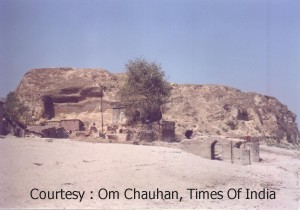
The mound of Jajmau, on the eastern end of the city occupies a high place among ancient
sities of the region. Excavations of the mound were undertaken during 1957-58 which
unearthed antiquities ranging from 600 BC to 1600 AD. Jajmau,known as Siddhapuri in
ancient times, is supposed to have been the kingdom of Yayati, the Pauranic king and the
high mound overhanging the Ganga is known as the site of his fort.
Today, Jajmau houses the Siddhnath and Siddha Devi temples and the mousoleium of Makhdum
Shah Ala-ul-Haq, the famous Sufi saint, built by Firoz Shah Tughlaq in 1358. A mosque
built by Kulich Khan in 1679 also stands here.
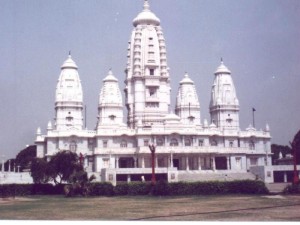 Shri Radhakrishna Temple (J.K. Temple)
Shri Radhakrishna Temple (J.K. Temple)
Beautifully constructed, J.K. temple is a boon to the devotees. Built by J.K. Trust this
architectural delight is a unique blend of ancient architecture with the modern. The
even-level roofs o the mandaps have been provided with adequate ventilation for sufficient
light and air. Among the five shrines that the temple has the central one s consecrated to
Shri Radhakrishna and the other are adorned with idols of Shri Laxminarayan, Shri.
Ardhanarishwar, Shri Narmadeshwar and Shri Hanuman.
Jain Glass Temple
It is situated in Maheshwari Mohal behind the
Kamla Tower. It is a beautiful temple highly decorated with glass and enamel works.
Allen Forest Zoo
The Kanpur Zoo was opend in 1971 and ranks among one of the best zoos in the country. It
is an ideal place for outdoor life and picnics amongst picturesque surroundings. Phone:
543678.
Kamla Retreat
Lies to the west of the Agricultural College in immediate neighbourhood of the Allen
Forest. It is under the possession of Singhania family and is a beauty spot of the city.
There is a swimming tank with an equipment for producing artificial waves and suitable
arrangement for lighting. Besides parks and a canal with facilities for boating, a zoo is
also maintained.
Kamla Retreat also houses a museum which has a good collection of historical and
archaeological artifacts. Visitors are allowed only with prior permission from:; Deputy
General Manager (Administration), Kamla Tower, Kamalanagar, Kanpur, UP. Phone: 311478
& 311479.
Phool Bagh
It is a beautiful park in the heart of the city on the Mall Road. In the centre of the
park is a building known as Ganesh Shanker Vidyarthi Memorial (K.E.M. Hall). After the
first World War there was an Orthopaedic Rehabilitation Hospital in this building. It is
now known as Ganesh Udyan.
Nana Rao Park
To the west of Phool Bagh is located the Nana Rao Park. It is the site of the
`Bibighar’ of 1857. The Park was renamed as Nana Rao Park after independence.
Dwarka Dhish Temple
Situated adjacent to Kamla Tower, this temple is dedicated to the worship of Lord
Krishna.
The jhoola dedicated during sravan is worth viewing in this Temple.
Phool Bagh
Also situated on Mall Road, it is generally used for public meetings.A part of garden is
specially well maintained where the annual flower shows are held. It also has a summer
house and a large public library is situated here.
Brijendra Swaroop Park
Situated in Aryanagar area of Kanpur,this park is also very big and has spacious lawns and
play grounds.
Moti Jheel
This is drinking water reservoir of Kanpur Waterworks. It is situated in the Benajhabar
area of the city The area around the jheel has recently been developed into a beautiful
recreation grounds & children parks.
Agricultural Gardens
Situated in Nawab Ganj area, it has very beautiful & shady drive and a variety of
botanical species are cultivated here.
Allen Forest Zoo
Situated beyond Nawab Ganj, north of Kanpur, it is a well known picnic spot and has forest
training school.This vast forest possesses well maintained zoo which abounds in the rare
species of animals.
Green Park Stadium
This is the best & the most famous play ground of Kanpur.International cricket matches
are held here and is considered to have one of the best pitches in the world.
Kamla Retreat
Situated beyond Nawab Ganj,this is an attractive health resort privately owned by the
Singhania Family of M/s Juggilal Kamlapat popularly known as the J.K passes for visisting
the resort can be obtained from the Kamla Tower, kanpur.
Massacre Ghat
On the right bank of the river Ganga in the Cantonment Area, lies this place of great
historical importance, since the time of India mutiny of 1857.The Ghat has been renamed as
Nanarao Ghat, in the memory of Nana Saheb Peshwa, who ejected the British from Kanpur.The
Ghat is also Known as Satti Chura Ghat, which was the scene of terrible massacre.
Other Places of Interest
Other Places of Interest are; Tapeshwaridevi Temple, Vankhahdeshwar Temple, Anandeshwar
Temple, Tulsi Upvan-Children Park, Botanical Garden, Prayag Narain Temple (Shivalaya),
Nanarao Ghat, Panki Hanuman Temple and Singhania Art Gallary.
Among other sites worth visiting at Kanpur are
the Hanuman temple-Panki, Anandeshwar temple, Jageshwar temple, Dwarikadhish temple,
Prayagnarayan temple, Kailash temple, Buddhadevi temple, Kherepati temple, Varahidevi
temple, Bhairav temple and Tulsi Upvan (Moti Jheel).
Excursions
Bithoor
The quiet and beautiful township of Bithoor is
situated on the Kannauj Road, 27 km from Kanpur. Situated on the banks of the Ganga, this
tranquil spot is of considerable historical and religious importance. According to Hindu
scriptures Lord Brahma came to Utpalaranya, as it was known then, for the creation of
mankind. The placewhich first witnessed the creation of mankind came to be known as
Brahmavarta or the seat of Brahma. Later Brahma installed a Shivalinga which is still
workshipped as Brahmeshwar Mahadeva at the principal ghat of Bithoor, the Brahmavarta
Ghat. A nail of the horse shoe embedded in the steps of the ghat is an object of special
reverence for devotees, considered to be of Brahma’s horse, while going for
Ashwamedha Yajna. On the completion of the yajna, the forests of Utpalaranya became known
as Brahmavarta, from which the popular name, Bithoor is derived.
In later centuries Brahmavarta flourished as a capital of the kingdom of Utpalaranya, over
which ruled the emperor Uttanpad. His son Dhruva penanced here in order to please Brahma.
The place is pointed out to be Dhruva Teela.
There is a small pool inside Valmiki Ashram, famous as Sita-Kund. Sita ‘Rasoi’
is still preserved, near which stands `Swarga Naseinee’ or Deep Malika Stambha,
studded with niches all around for illumination. The tower has about 48 steps leading to
its top which is surmounted by a cupola, from where one can heave a panoraic viewof the
entire area. The existing Valmiki temple is said to have been rebuilt by Baji roa Peshwa
in the 19th century.
Later Brahmavarta fell into obscurity, only to regain prominence in the 18th century.
During 1753-75 under the rule of Nawab Shuja-ud-daula, the administration of Bithoor was
entrusted to Almas Ali Kha, who erected a mosque near Lakshman Ghat on the right bank of
Ganga.
Bithoor was the capital of the Pargana from 1811 to 819. After the departure of the
courts, the place was assigned as a residence to Baji Rao, the deposed Peshwa. The Palace
of Nana Sahib was reduced to rubble by the British in 1857 and the only traces remaining
of it are some large well heads and broken palace walls.
The historic town of Bithoor, once famous by the name of `Bavan Ghaton ki Nagri’,
[city of 52 Ghat (river banks)] today left with only 29 ghats. The chief among them
being-the Tuta Ghat, Patkapur Ghat, Khanderao Gaht, Rishikul Ghat, Kalvari Ghat, Hanuman
Ghat, Chhappar Ghat, Dhruv Ghat, Bhairav Ghat, Sita-Kaushalya Ghat, Bramhavarta Ghat,
Ganesh Ghat, Lakshman Ghat, Rambhushan Ghat, Pandav Ghat, Jhansi Rani Ghat, Mahapatra
Ghat, Chhatta Ghat, Shuklan Ghat, Mahila Ghat, Baradari Ghat, Patthar Ghat, Bhajju Ghat,
Gudara Ghat, Atmanand Saraswati Ghat, Maharaja Peshwa Ghat, Gulariya Ghat, Haridham Ghat,
Shivdham Ghat and Kapileshwar Ghat. Of these 29 Ghats the most beautiful is the Patthar
Ghat, built by Raja Tikaitrai. The other important Ghat of Bhthoor is the Kalvari Ghat,
where a large Gaesh temple built by the Peshwas exists. Other notable sites at Bithoor are
the Tripura Sundri Temple, Shivananda Ashram, Gyaneshwar Mahadev Temple, Janki Temple,
Pantha Devi Temple, and Sri Gayatri Dham. Bithoor has no hotels at present, one can either
choose to stay at Ashrams or return to Kanpur for nightstay. UP Government Tourist
accommodation is available at tourist motel, Tatyaganj, 12 km. before Bithoor, on route to
Farrukhabad.
Bhitargaon
59 km. Situated in Ghatampur tehsil, Bhitargaon houses a unique architectural specimen
– a brick temple belonging to the Gupta era. The very first shrine with a Shikara, it
dates back to 600 AD.
Built of large bricks of size 0.47m x 0.22m x 0.07m, set in mud mortar, the total height
of the temple is 15.41m. inside the temple only the sanctum or garbhagriha and the porch
exists. Above the sanctum there was an upper chamber which was damaged when the spire was
struck by lightning some time in the 18th century. The most remarked feature of the temple
is its recessed plan.
The interior of the temple is plain but on the outside it is decorated with carved
brickwork and numerous terracotta panels of skilful workmanship. The importance of the
Bhitargaon temple lies in the fact that it is the sole surviving record of this early
phase of temple architecture in India.
Musanagar
65 km from Kanpur, the ancientsite of Masanagar with innumerable munds deserved mention on
account of the ancient temple of Muktadevi, which is said to have been built in Treta-Yug
by Raja Bali. A large fair is held at Muktadevi temple on occasion of Kartik Poornima.
Musanagar is also a rich archaeological site and has yielded a large number of artifacts
and specimens of the post Harrapan, Shunga, Maurya and Kushana periods. The Muktadevi
temple also offers an excellent view of the surrounding landscape. One can climb the roof
of the temple dharamshala, from where can be seen the meandering Sengar river meeting the
Yamuna down below, in a beautiful natural setting.
Kannauj
80 km. Situated on the banks of the river Ganga, Kannauj was the 7th century capital of
Emperor Harshvardhan’s empire, which encompassed the entire region between the rivers
Satlej and Narmada and eastern Bengal. While all traces of this past have vanished,
Kannauj is famous for its manufacture of essence (itr) used in perfumes.
Lucknow
The capital of Uttar-Pradesh, Lucknow is around 80km from Kanpur, well connected with
Trains/Buses/Taxi. Lucknow is a city synonymous with the Nawabi Culture. The imperialistic
splendour and magnificence of the Nawabi era has been glorified and eulogized down the
ages by writers, poets and historians alike. At the same time its mystical elegance and
amorous ethos has caught the fascination of many world famous romantics. Known for its
adab and Tehzeeb (cultural refinement), Lucknow is also associated with its legendary
hospitality, leisurely moods of life, fabled edifices steeped in history, world renowned
cuisine and exquisite Sham-e- Awadh. Tremors of time have not effaced Lucknow of its
cultural heritage and traditions, which once contributed in creating the city incomparable
in its times.
Angira Ashram
Thousands of years ago, one of the saptarishis, Maharishi Angira, chose for his penance a
place near Bithoo, presently situated in Ankui village today is known as the Angira
Ashram. The ancient Jagannath temple here houses the original wooden idol of Lord
Jagannath, said to be identical with that of the famous Jagannath temple.
Nawabganj Bird Sanctuary
43 km from Lucknow, along the Lucknow-Kanpur highway near Unnao, is the Nawabganj Bird
Sanctuary. The sanctuary attractts rare Siberian migratory birds during winters, the main
bird species being Pintain, Pigeon, Common teal, Shoveller, Pochard, Coot, Purple Moorhen
and others. The ideal season for bird watching is between December and March. The
Priyadarshini Motel of U.P. Tourism provides good boarding and lodging facilities at the
sanctuary.
Archaeological Sites around
Kanpur
Among other notable archaeological sites around Kanpur are the `Shiv temple at Nimbia
Khera’, the `Jagannath temple at Behta Buzurg’ and the `Lala Bhagat
Pillar’. Nimbia Khera is 12 km east of Ghatampur, where a 9th-10th Century old Shiva
temple at Behta Buzurg is supposed to be 2000 years old. It is said that a week before the
beginning of therainy season, drops of water falls from the stone which is embedded in the
inner roof of the temple. The village of Behta Buzurg is 15 km from Ghatampur and 40 km
from Kanpur, on the road going from Ghatampur to Sarh. Lala Bhagat, 92 km from Kanpur and
58 km from Derapur, houses the famous Kukkutadhwaj, more known as Lala Bhagat Pillar
standing in the middle of a modern temple. This red sandstone six and a half feet high
octagonal pillar with a small inscription was once surmounted by a cock capital, which
broken from the pillar shaft lies nearby. Datable to the 1st century AD, the cock capital
is of unique antiquity value.
Other Excursions
Hanuman Temple, Panki, Kalpi, Sankisa, Nawabganj and Kampil.
Clubs
CAWNPOR CLUB
Also situated on Cantonment
area, it is one of the oldest clubs of kanpur. It has a swimming pool, Tennis & Squash
courts and indoor games Facility. A well equipped library is also situated here.
GOLF CLUB
Situated on Cantonment area, on the banks of the river Ganga, it has grounds
and panoramic view.
GANGES CLUB
In Aryanagsr area of Kanpur,
it has Tennis & Badminton Courts and indoor games facility.
KANPUR UNION CLUB
Behind the Phul bagh on the
Mall Road, this also has Tennis & Badminton Courts and indoor games facility.All India
Tennis Tournaments are held here.
FLYING CLUB
Situated in Civil aero-drome,
it imparts flying training to its members.
 Believed to be founded by king Hindu Singh of the erstwhile state of Sachendi,
Kanpur was originally known as `Kanhpur’.
Historically, Jajmau on the eastern outskirts of present day Kanpur is
regarded as one of the most archaic tounships of Kanpur district.Upto the 1st
half of the 18th century Kanpur continued to survive as an insignificant village.
Its fate, however, took a new turn soon after. In May 1765,
Shuja-ud-daula, the Nawab Wazir of Awadh, was
defeated by the British near Jajmau. It was probably
at this time that strategic importance of
the site of Kanpur was realised by the British. European
businessmen had by this time gradually started
establishing themselves in Kanpur. In order to ensure protection to
their lives and property the `Awadh local forces’ were
shifted here in 1778. Kanpur passed into British hands under the treaty of
1801 with Nawab Saadat Ali Khan of Awadh. This forms a
turning point in the history of Kanpur. Soon Kanpur became one of the most
important military station of British India. It was declared a district on 24th March
1803.
Believed to be founded by king Hindu Singh of the erstwhile state of Sachendi,
Kanpur was originally known as `Kanhpur’.
Historically, Jajmau on the eastern outskirts of present day Kanpur is
regarded as one of the most archaic tounships of Kanpur district.Upto the 1st
half of the 18th century Kanpur continued to survive as an insignificant village.
Its fate, however, took a new turn soon after. In May 1765,
Shuja-ud-daula, the Nawab Wazir of Awadh, was
defeated by the British near Jajmau. It was probably
at this time that strategic importance of
the site of Kanpur was realised by the British. European
businessmen had by this time gradually started
establishing themselves in Kanpur. In order to ensure protection to
their lives and property the `Awadh local forces’ were
shifted here in 1778. Kanpur passed into British hands under the treaty of
1801 with Nawab Saadat Ali Khan of Awadh. This forms a
turning point in the history of Kanpur. Soon Kanpur became one of the most
important military station of British India. It was declared a district on 24th March
1803.

 The Kanpur Memorial Church
The Kanpur Memorial Church
 Shri Radhakrishna Temple (J.K. Temple)
Shri Radhakrishna Temple (J.K. Temple)